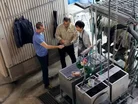How to grow manufacturing sales effectiveness with lead velocity

Many manufacturing marketers have traditionally focused on the number of leads as a key metric. It’s easy to work under the theory that the more leads that flow into the top of the sales funnel, the more that will convert to a completed sale. Yet, more isn’t always better. A laser focus on lead velocity, that is, improving the conversion rate for leads as they move through the sales pipeline, translates into greater revenue returns while increasing sales confidence.
When Marketing focuses on volume, Sales ends up going through high numbers in the hopes of finding the hot leads included in the mix. While there is a finite number of customers in the market for a product at any given time, there is a point of diminishing returns. When Marketing sends Sales too many, they risk losing the Sales department’s trust and with it, the value of any leads they pass on.
Velocity, the rate at which leads convert as they travel through the sales funnel, is the answer. Here are four clear reasons why:
Increase in Lead Generation ROI
Whether a direct lead, or a lead through the channel, manufacturing marketers today have to maximise their use of time and resources to prioritise prospective customer interest. Organisations that nurture leads experience an increase in lead generation ROI. After all, the velocity with which leads are converted to sales-qualified leads increases efficiency while ensuring Sales spends its time having high quality conversations. For example, Bisco Industries, a manufacturer of electronic components and fasteners, implemented lead nurturing and benefited from a 1,400% lead generation ROI, winning the 2017 Nucleus Research ROI Award.
Segmentation, tailored content and lead nurturing
While over half of manufacturing marketers don’t currently segment prospects at all, tailoring content to individual buyers increases lead conversion significantly. Velocity-centric marketing encourages segmentation, nurturing each lead based on things like product interest, position, industry, and more. According to Wakefield Research, 77% of manufacturing organisations conduct more than 10 promotions a year with 46% running more than 21.
See also
- Bosch partners with Amadeus and Chrome River for business travel solutions
- Toyota partners with Gordon Institute of Business Science to offer Africa's first Manufacturing MBA
- Saint Gobain releases new strategy to improve savings in construction
Case in point: Last year Bisco Industries began delivering near real-time content to prospects, tailored to how those prospects liked to engage with the company. In doing so, they nurtured prospects through the buying journey from initial engagement to quote request, to placing an order and setting up a Bisco credit account. These customers were then further nurtured, adding new product lines to their account. With this approach, tailoring content to different prospects at different times in the buying process, Bisco increased its conversion rate by 1,285%. While Bisco only grew new opportunities by 4%, its enhanced conversions resulted in an average annual benefit of $301,388.
Increased sales efficiency increases sales impact
Even small, incremental increases in conversion rates can result in significant sales impact. When marketers focus on lead volume, a huge amount of effort is wasted with clearly unqualified leads - effort that could be used on leads that have a higher likelihood of conversion and ROI. In addition, a bonus side effect to an increase in velocity is that Sales can reinvest previously wasted effort in upsell and cross-sell activities, making them even more productive.
Sales Marketing Alignment
In order to affect positive change in conversion across the sales funnel, it’s important for the Sales and Marketing teams of a business to work together, and to make sure they have common definitions for the sales and marketing process. For example, both departments need to ensure that they agree on what counts as a lead, an MQL, SQL, Opportunity, etc. With these definitions in hand, they should then measure the lead conversion rate from each stage to the next. Key questions to ask are:
- What is the current velocity of prospects in the pipeline?
- Which prospects move faster today and why?
- Are there any bottlenecks in the process?
The more effective the funnel, the more efficient it is at converting at all levels, which can have an important impact on marketing and sales productivity - and most importantly, on sales outcomes. Segmentation and personalised nurturing campaigns will speed up the rate of conversion velocity and increase the quality of leads that are sent to the sales organisation. This will in turn grow Sales’ productivity, help them win more customers and make more sales, and increase Sales’ confidence in the marketing process and the marketing team.
Nina Church-Adams is Senior VP, Marketing at Act-On where she manages the company’s global marketing function, bringing more than 14 years of marketing leadership experience building teams, products, and brands at industry leading companies such as Nike and American Express.
- Bilfinger UK: Making digitalisation a reality in the process industrySmart Manufacturing
- Spirit AeroSystems and an advanced UK Research Centre join forces to accelerate the aerospace sectorLean Manufacturing
- Rockman Industries appoints Fortinet to protect its manufacturing plants from digital threatsTechnology
- Accenture is acquiring ESP to support life sciences clients digitise their manufacturing operationsTechnology

